Study on Reinforcement Measures for Wood Composite Beams with Discontinuous Cross-Section in Web Opening
Abstract
1. Introduction
2. Finite Element Model
2.1. Material Properties
2.2. Mesh Division and Boundary Conditions
2.3. Comparison of Test and FEA Results
3. Specimen Size and Reinforcement Measures
4. Analysis of Results
4.1. Bearing and Deformation Capacity
4.2. Shear Analysis of the Opening Area
4.3. Analysis of Bolt and Screw Reinforcement Effect
4.4. Analysis of Plywood Reinforcement Effect
4.5. Analysis of CFTWS Reinforcement Effect
5. Conclusions
- The six types of reinforcement measures set up in the opening area can make up for the loss of bearing capacity and deformation capacity caused by the web opening, and the main damage modes of the structure affected by the reinforcement measures are shown as the shear damage in the opening area and the bending and stretching damage at the bottom of the beam in the middle of the span.
- Bolts and screws, when used as reinforcement measures, cannot avoid the generation of opening cracks, although they can help transfer shear stresses to a certain extent and increase the ultimate bearing capacity by 29%, as well as inhibit the longitudinal development of cracks.
- The composite beams showed the best co-deformation with plywood reinforcement. The plywood helps to carry 14% to 31% of the shear value, which ultimately improves the ultimate bearing capacity of the wood composite beams by 33% to 47%, but the structure is prone to brittle damage in the opening area.
- The effectiveness of CFTWS reinforcement is directly related to the type of connection. CFTWSs are susceptible to local buckling in the opening area when only bolted connections are used. The composite connection can effectively avoid local buckling, optimize the force transfer path, and help to bear 76% of the shear force value so that the ultimate bearing capacity and deformation capacity are increased by 59% and 39%, respectively. The bolts–epoxy–cold-formed thin-walled steel composite reinforcement was used to improve wood composite beams’ stiffness and bearing capacity with web openings.
Author Contributions
Funding
Data Availability Statement
Acknowledgments
Conflicts of Interest
References
- Ramage, M.H.; Burridge, H.; Busse-Wicher, M.; Fereday, G.; Reynolds, T.; Shah, D.U.; Wu, G.; Yu, L.; Fleming, P.; Densley-Tingley, D.; et al. The Wood from the Trees: The Use of Timber in Construction. Renew. Sustain. Energy Rev. 2017, 68, 333–359. [Google Scholar] [CrossRef]
- Buchanan, A.H.; Levine, S.B. Wood-Based Building Materials and Atmospheric Carbon Emissions. Environ. Sci. Policy 1999, 2, 427–437. [Google Scholar] [CrossRef]
- Kamala, B.S.; Kumar, P.; Rao, R.V.; Sharma, S.N. Performance Test of Laminated Veneer Lumber (LVL) from Rubber Wood for Different Physical and Mechanical Properties. Holz Roh Werkst. 1999, 57, 114–116. [Google Scholar] [CrossRef]
- Issa, C.A.; Kmeid, Z. Advanced Wood Engineering: Glulam Beams. Constr. Build. Mater. 2005, 19, 99–106. [Google Scholar] [CrossRef]
- Yeoh, D.; Fragiacomo, M.; De Franceschi, M.; Heng Boon, K. State of the Art on Timber-Concrete Composite Structures: Literature Review. J. Struct. Eng. 2011, 137, 1085–1095. [Google Scholar] [CrossRef]
- Khorsandnia, N.; Valipour, H.; Schänzlin, J.; Crews, K. Experimental Investigations of Deconstructable Timber–Concrete Composite Beams. J. Struct. Eng. 2016, 142, 04016130. [Google Scholar] [CrossRef]
- Hassanieh, A.; Valipour, H.R.; Bradford, M.A. Experimental and Numerical Study of Steel-Timber Composite (STC) Beams. J. Constr. Steel Res. 2016, 122, 367–378. [Google Scholar] [CrossRef]
- Chien, T.-P.; Yang, T.-H.; Chang, F.-C. Flexural Performance of Built-Up Beams Made with Plantation Wood. Forests 2019, 10, 647. [Google Scholar] [CrossRef]
- Zhu, E.C.; Guan, Z.W.; Rodd, P.D.; Pope, D.J. Buckling of Oriented Strand Board Webbed Wood I-Joists. J. Struct. Eng. 2005, 131, 1629–1636. [Google Scholar] [CrossRef]
- Ghanbari-Ghazijahani, T.; Russo, T.; Valipour, H.R. Lightweight Timber I-Beams Reinforced by Composite Materials. Compos. Struct. 2020, 233, 111579. [Google Scholar] [CrossRef]
- Borri, A.; Corradi, M. Strengthening of Timber Beams with High Strength Steel Cords. Compos. Part B Eng. 2011, 42, 1480–1491. [Google Scholar] [CrossRef]
- Wu, H.; Liao, W.; Liu, D.; Zhou, X.; Chen, Z. Mechanical Properties of Composite Beams with Web Openings under Negative Bending Moments. Structures 2023, 58, 105394. [Google Scholar] [CrossRef]
- Zhou, X.; Liao, W.; Liu, D. Ultimate Bearing Capacity of Composite Beams with Reinforced Web Opening under Hogging Moment: Practical Calculation Method. Structures 2023, 47, 2531–2540. [Google Scholar] [CrossRef]
- Aicher, S.; Tapia, C. Novel Internally LVL-Reinforced Glued Laminated Timber Beams with Large Holes. Constr. Build. Mater. 2018, 169, 662–677. [Google Scholar] [CrossRef]
- Darwin, D.; Donahey, R.C. LRFD for Composite Beams with Unreinforced Web Openings. J. Struct. Eng. 1988, 114, 535–552. [Google Scholar] [CrossRef]
- Chen, G.; Li, H.; Zhou, T.; Li, C.; Song, Y.; Xu, R. Experimental Evaluation on Mechanical Performance of OSB Webbed Parallel Strand Bamboo I-Joist with Holes in the Web. Constr. Build. Mater. 2015, 101, 91–98. [Google Scholar] [CrossRef]
- Hallstriim, S. Glass Fibre Reinforced Holes in Laminated Timber Beams. Wood Sci. Technol. 1996, 30, 323–337. [Google Scholar]
- Ardalany, M.; Fragiacomo, M.; Moss, P.; Deam, B. An Analytical Model for Design of Reinforcement around Holes in Laminated Veneer Lumber (LVL) Beams. Mater. Struct. 2013, 46, 1811–1831. [Google Scholar] [CrossRef]
- Ardalany, M.; Fragiacomo, M.; Deam, B.; Crews, K. Analytical Cracking Load Estimation of Laminated Veneer Lumber (LVL) Beams with Holes. Eur. J. Wood Wood Prod. 2013, 71, 37–48. [Google Scholar] [CrossRef]
- Leichti, R.J.; Falk, R.H.; Laufenberg, T.L. Prefabricated Wood I-Joists: An Industry Overview. For. Prod. J. 1990, 40, 15–20. [Google Scholar]
- Karimi-Nobandegani, A.; Valipour, H. Timber Beams with Openings: Laboratory Testing and Nonlocal Finite Element Modelling. Eng. Struct. 2021, 245, 112867. [Google Scholar] [CrossRef]
- Karimi-Nobandegani, A.; Valipour, H. Effect of Web Openings on Timber Composite Beams: Testing and Analytical Modelling. Eng. Struct. 2022, 256, 114064. [Google Scholar] [CrossRef]
- Xu, D.; Li, Y.; Zhang, Z. The Application of Cohesive-Zone Models in Deformation Analysis of Steel Bamboo Composite Beams. China For. Prod. Ind. 2018, 45, 42–47. [Google Scholar] [CrossRef]
- GB 5005-2017; Standard for Design of Timber Structures. Standards Press of China: Beijing, China, 2017.
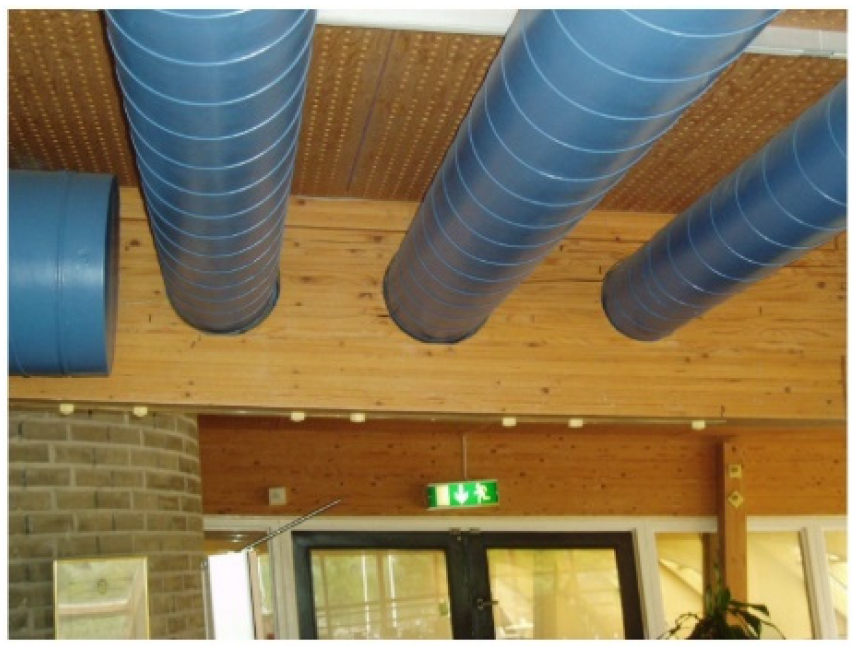
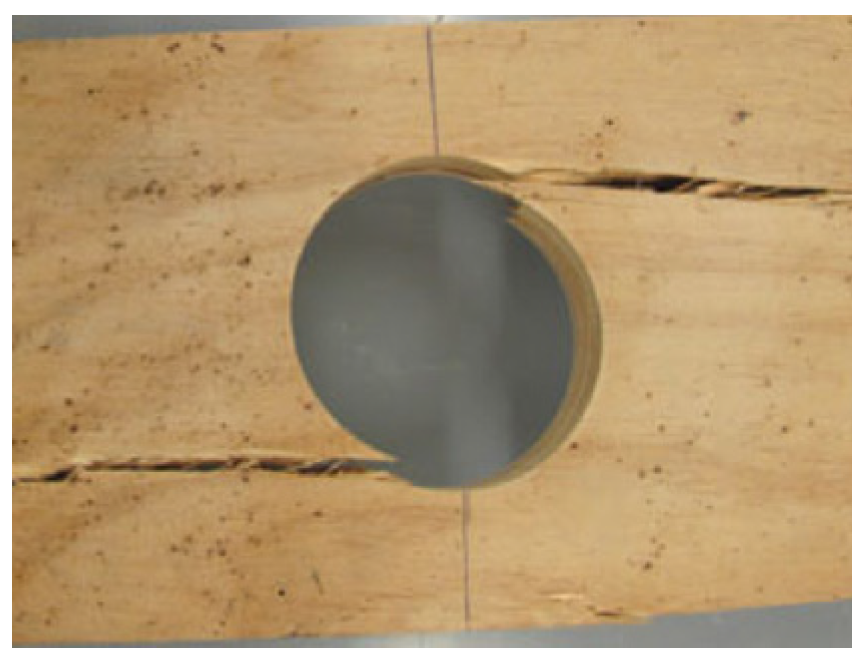
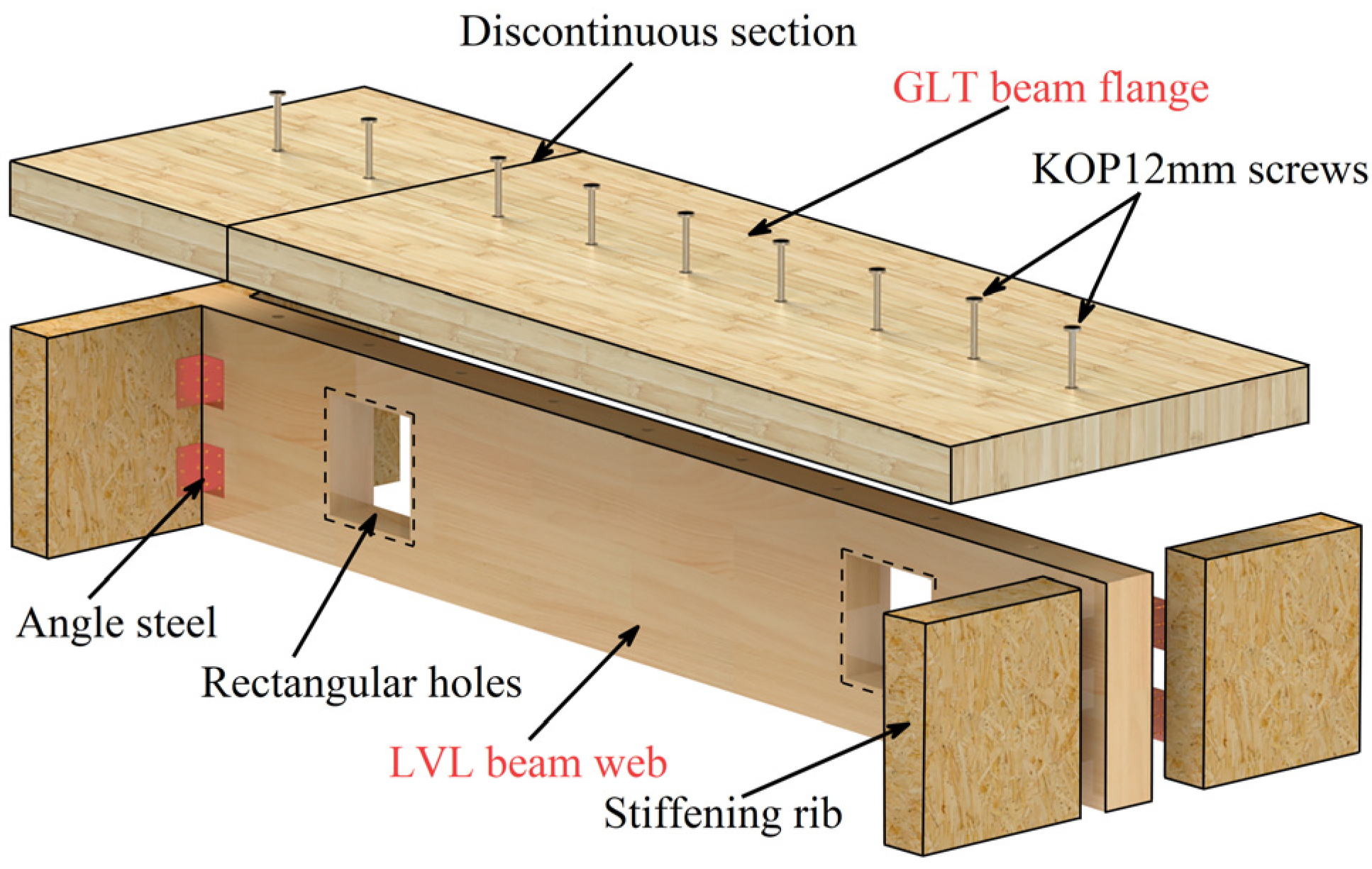
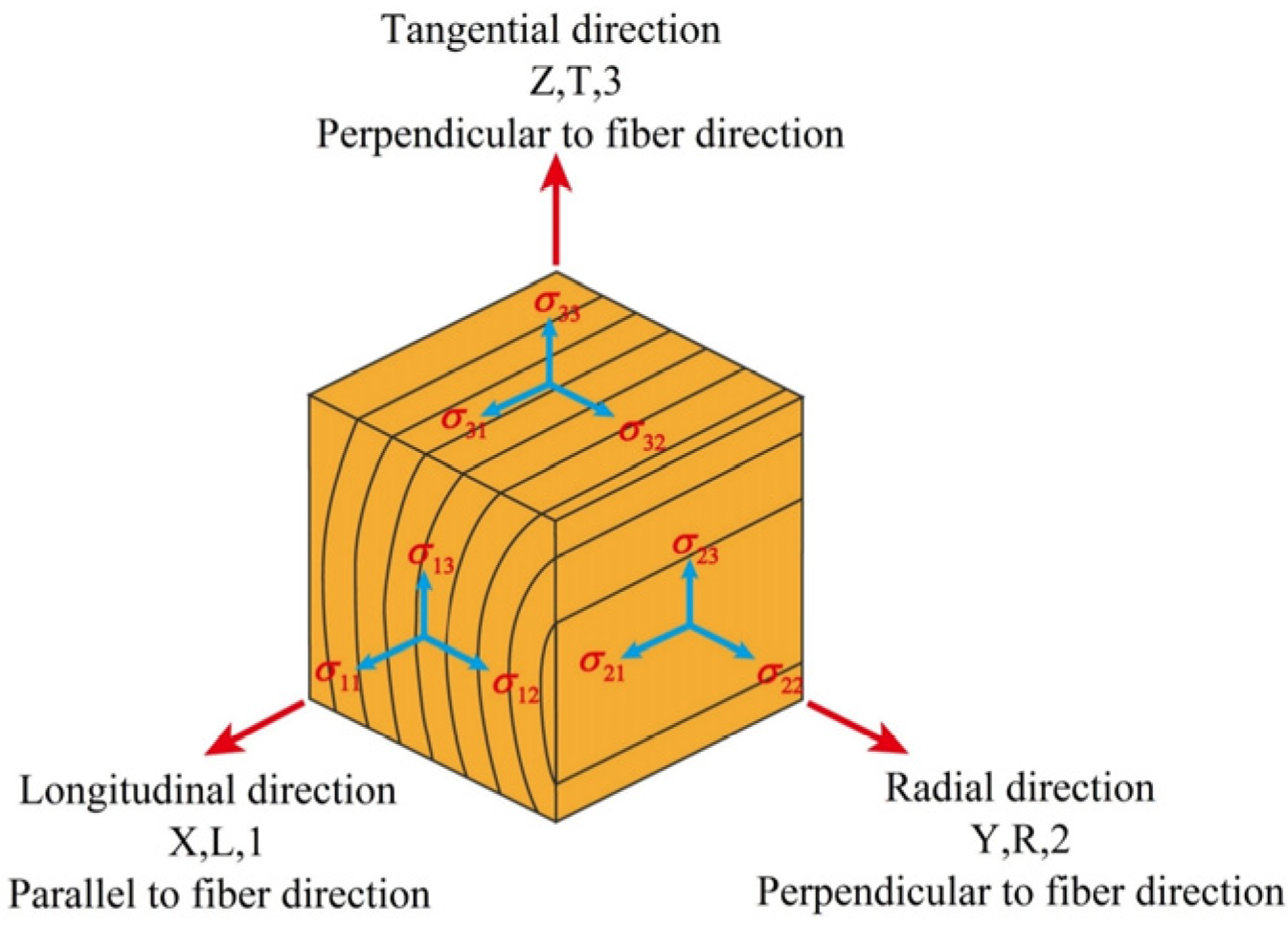

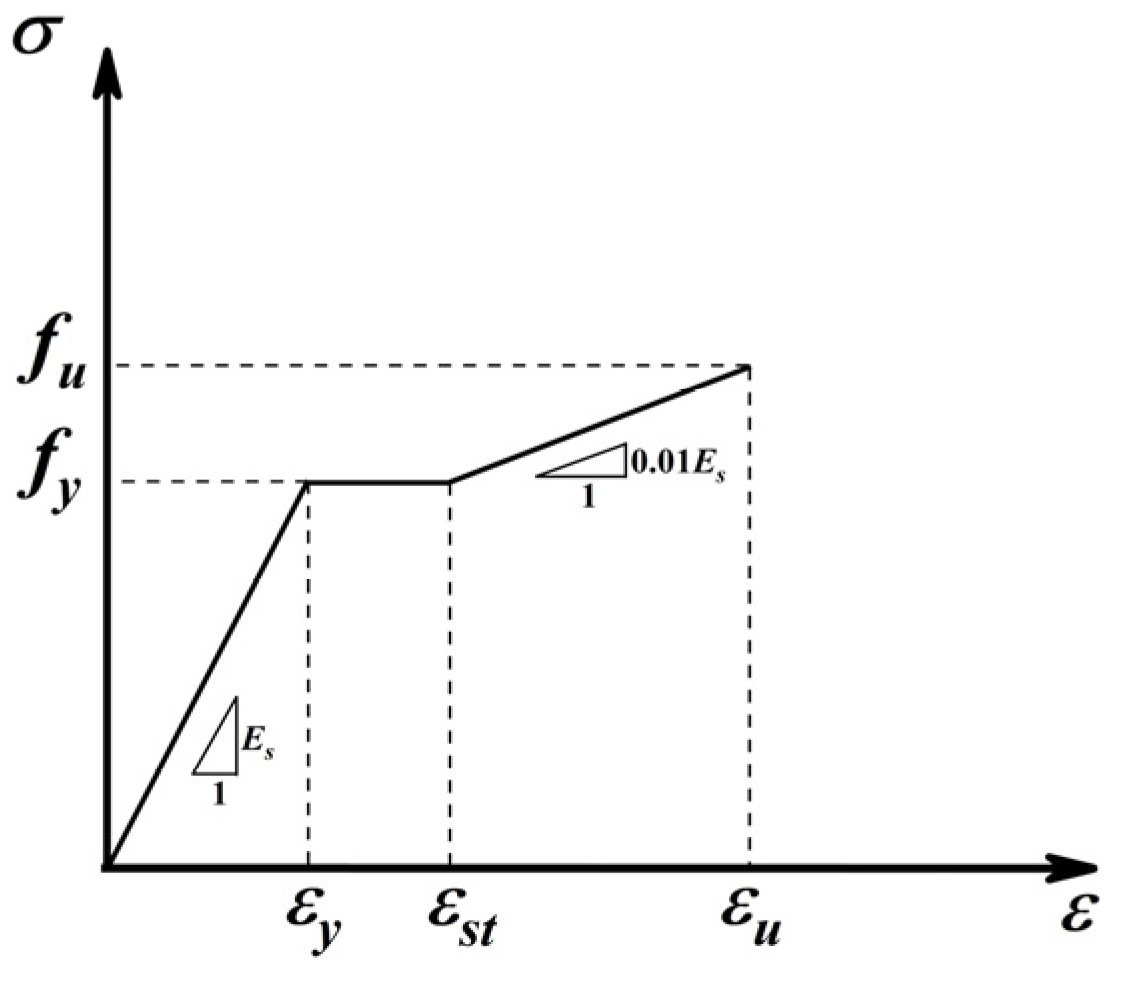
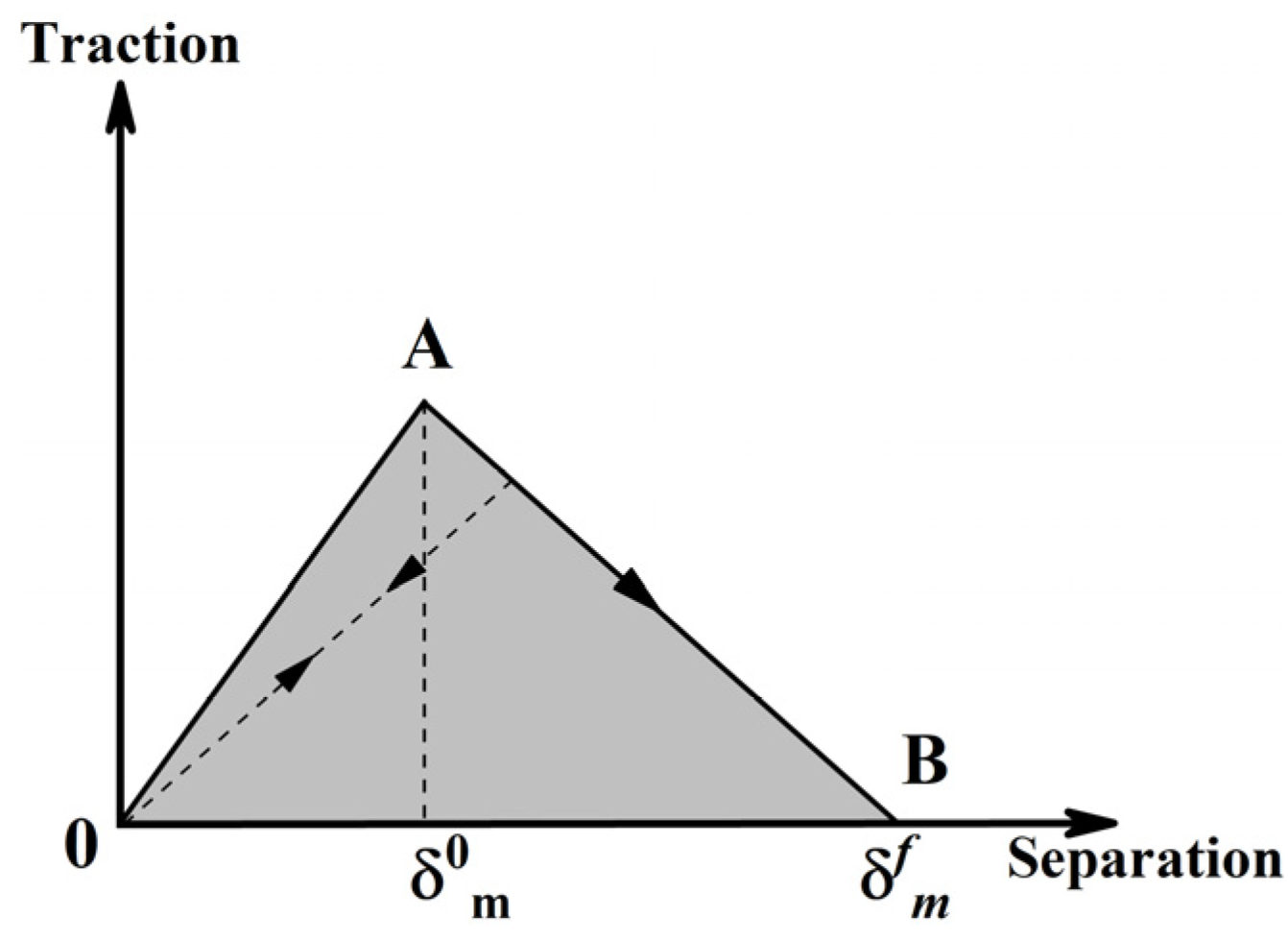
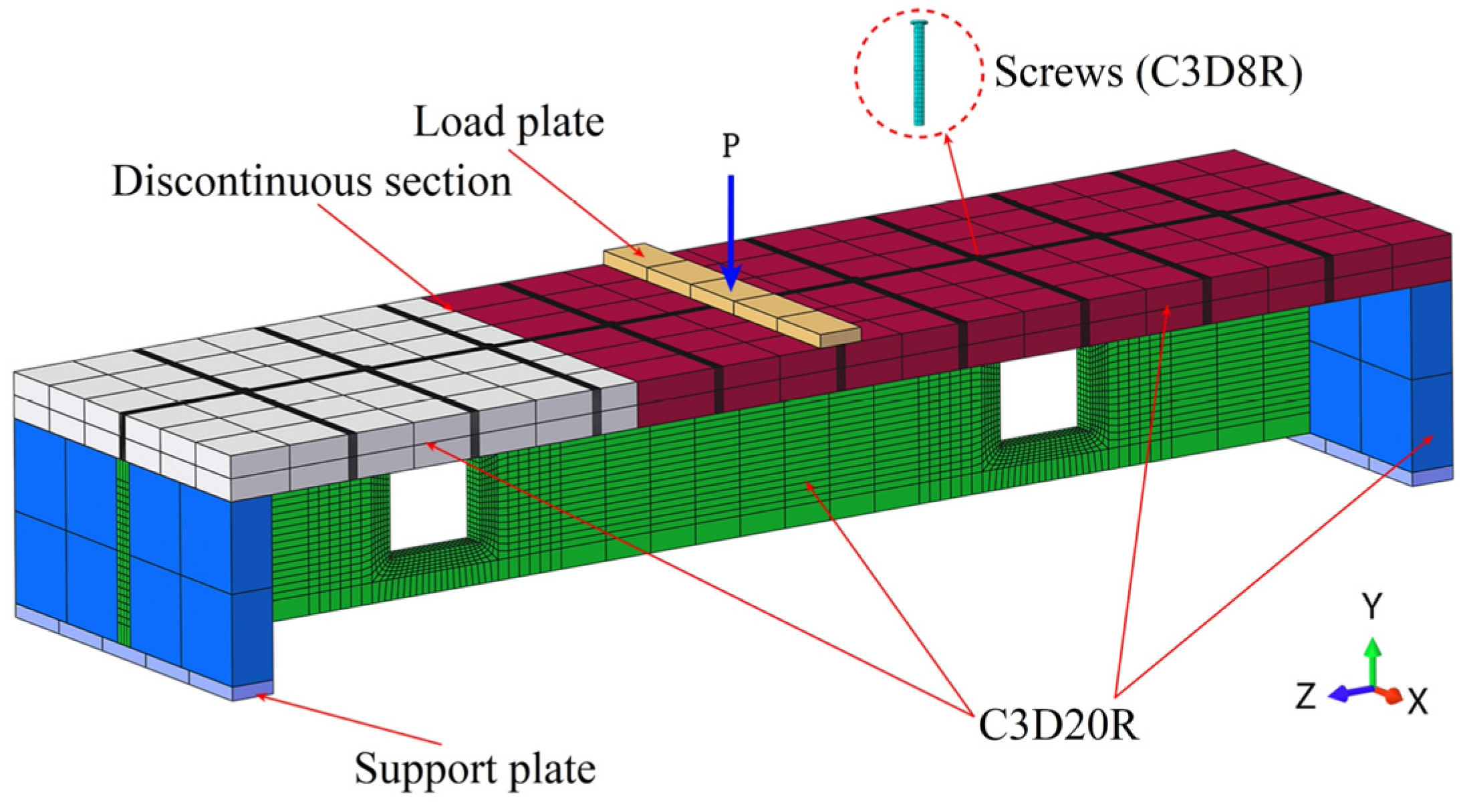
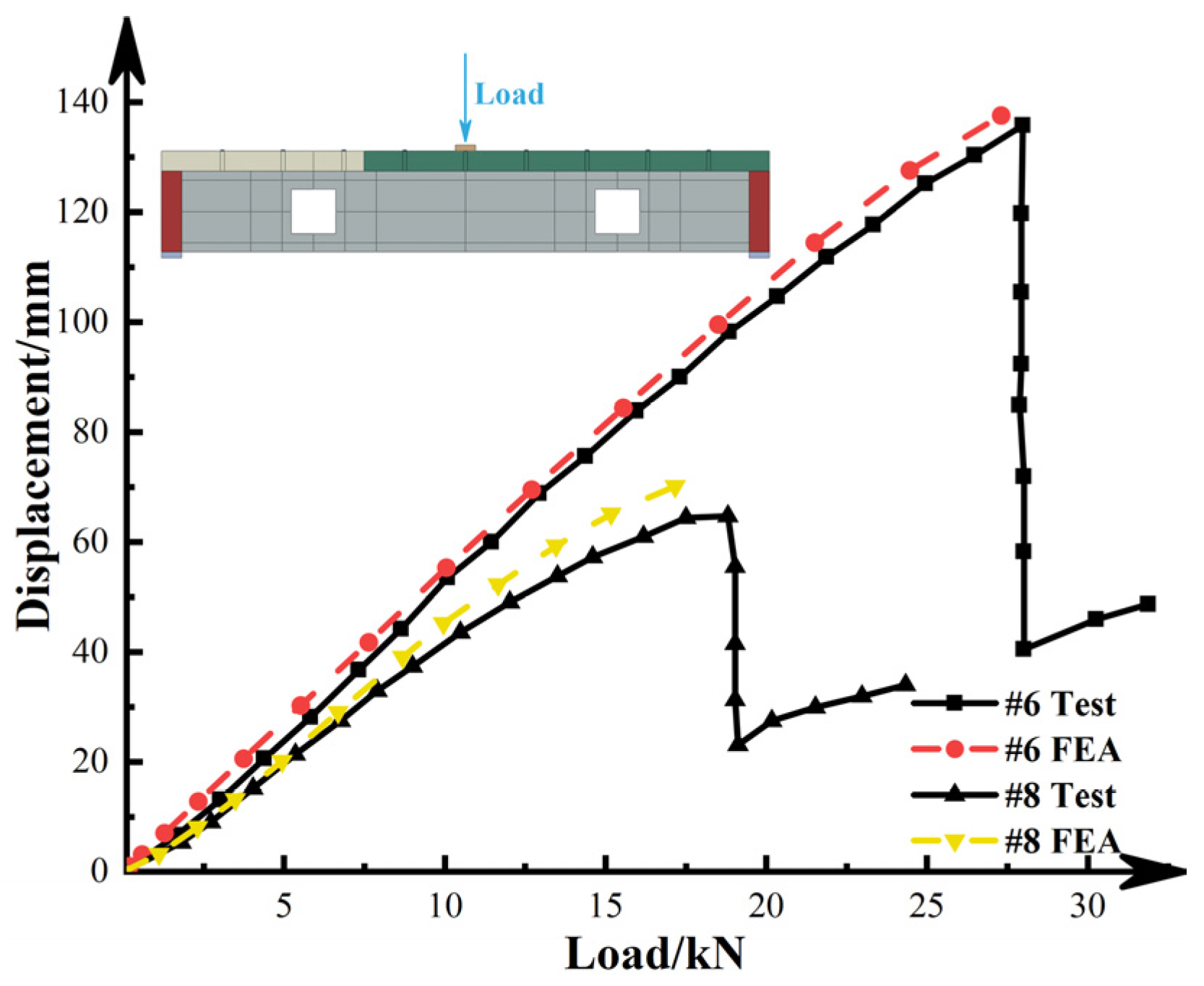
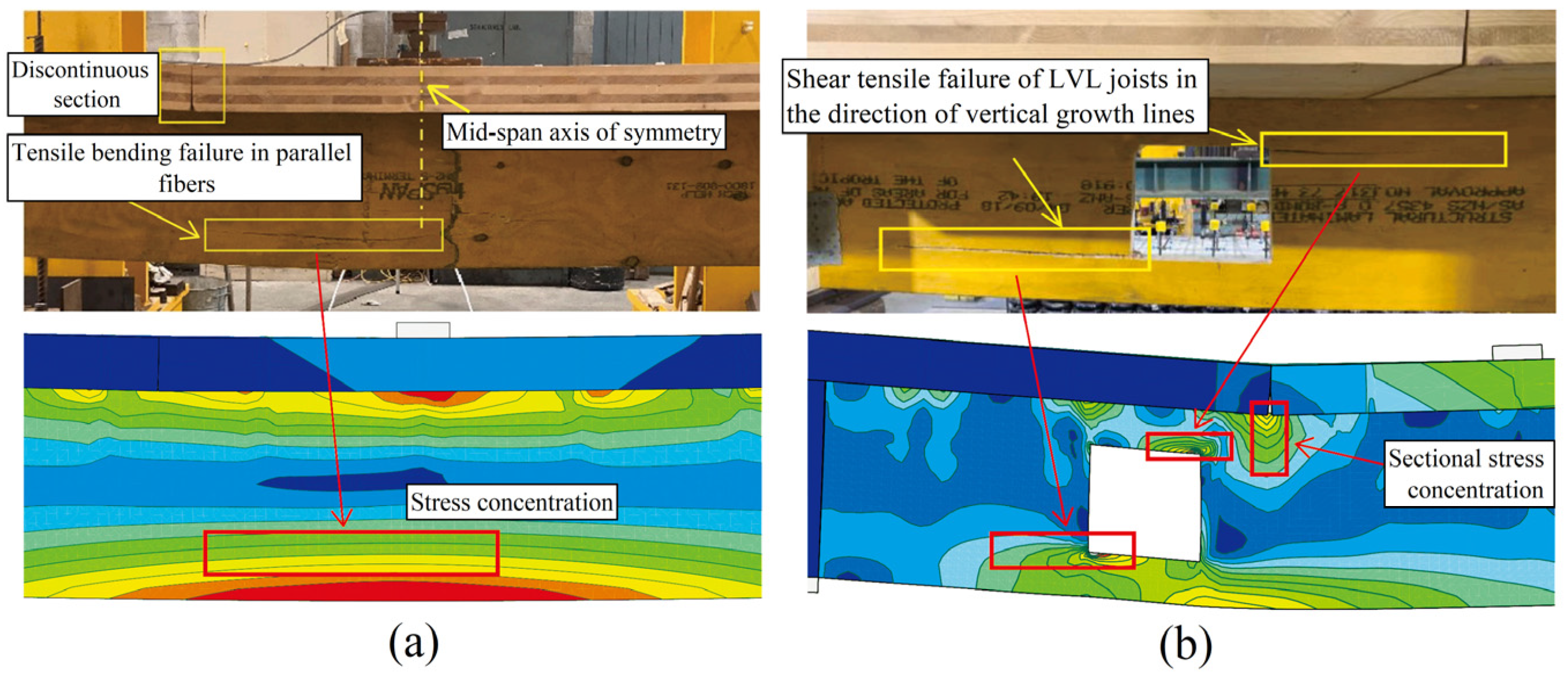



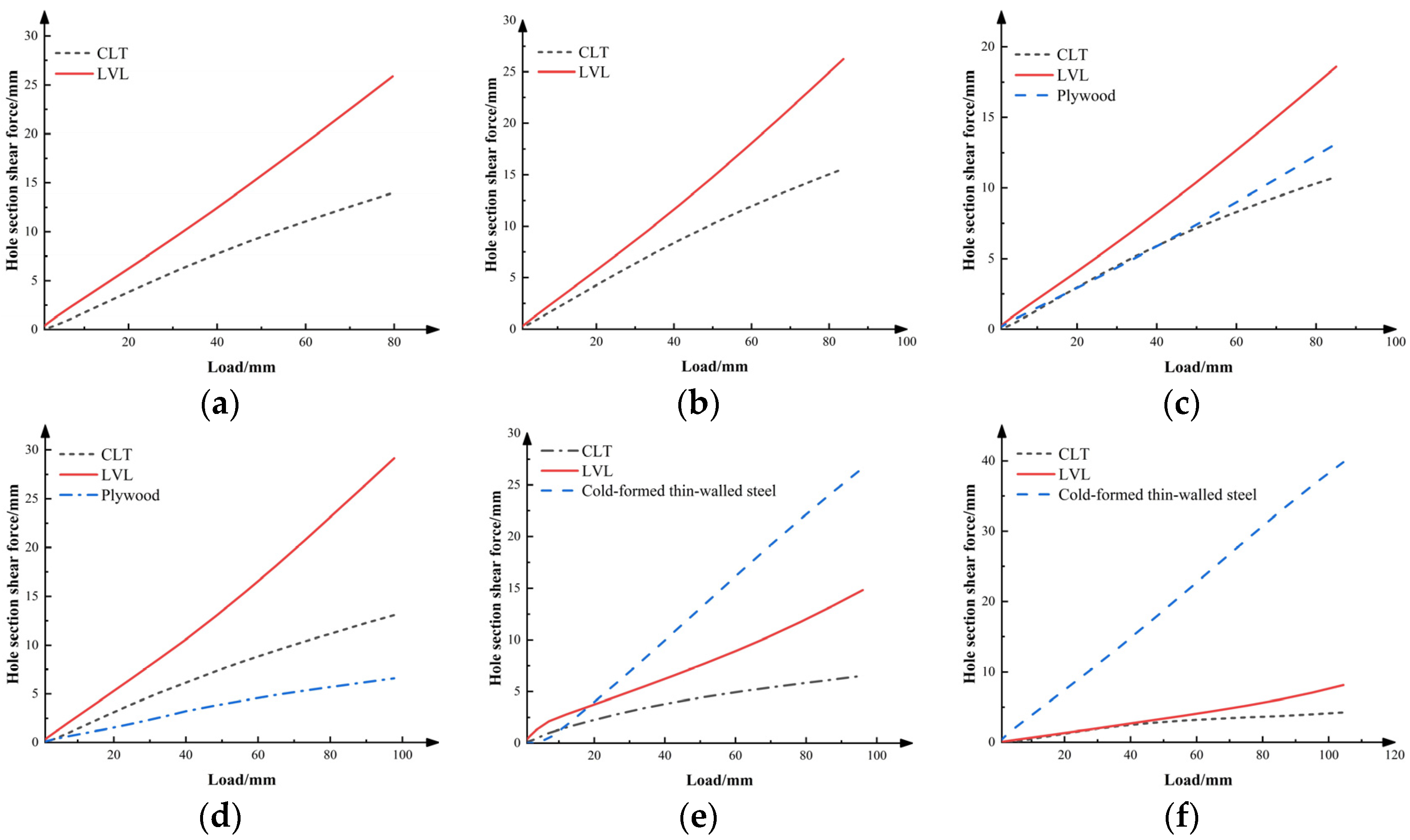
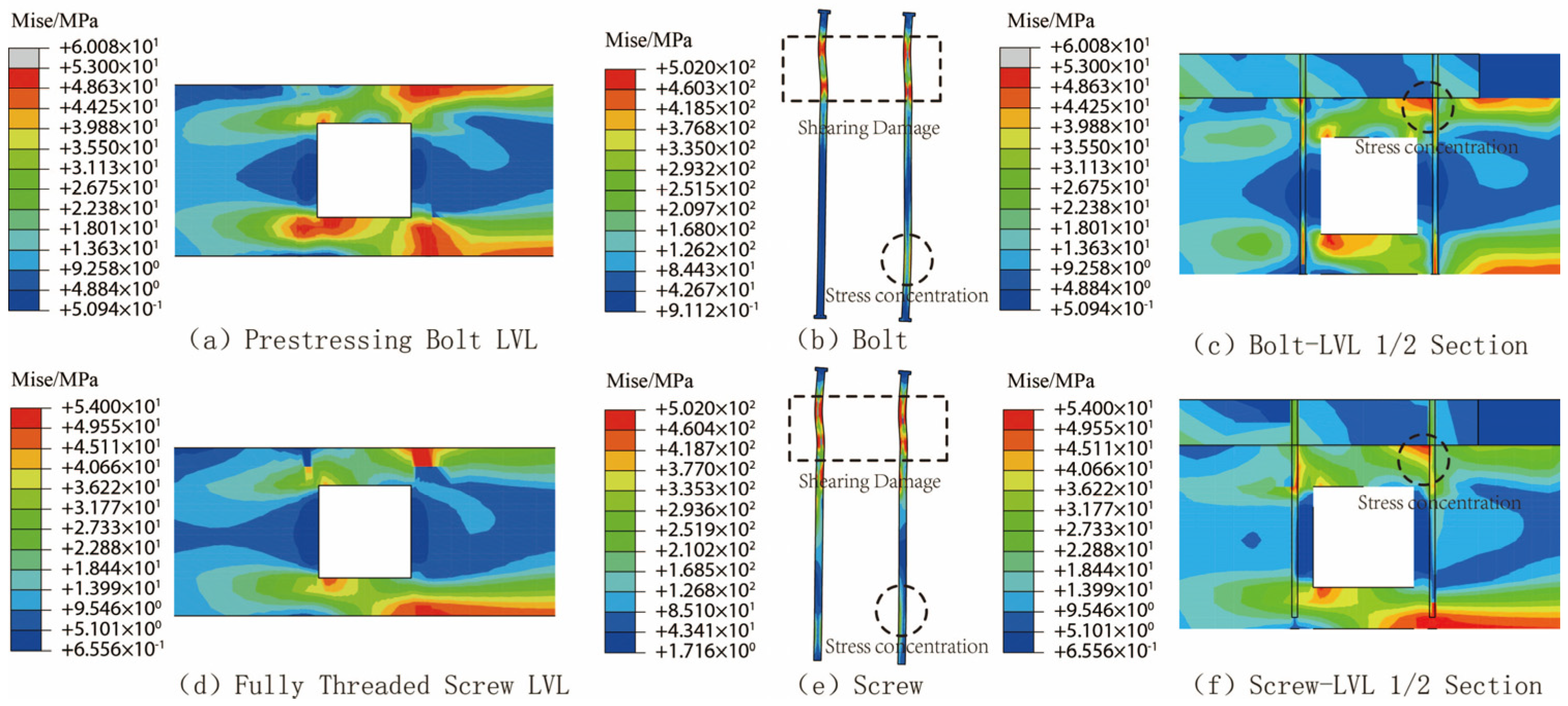
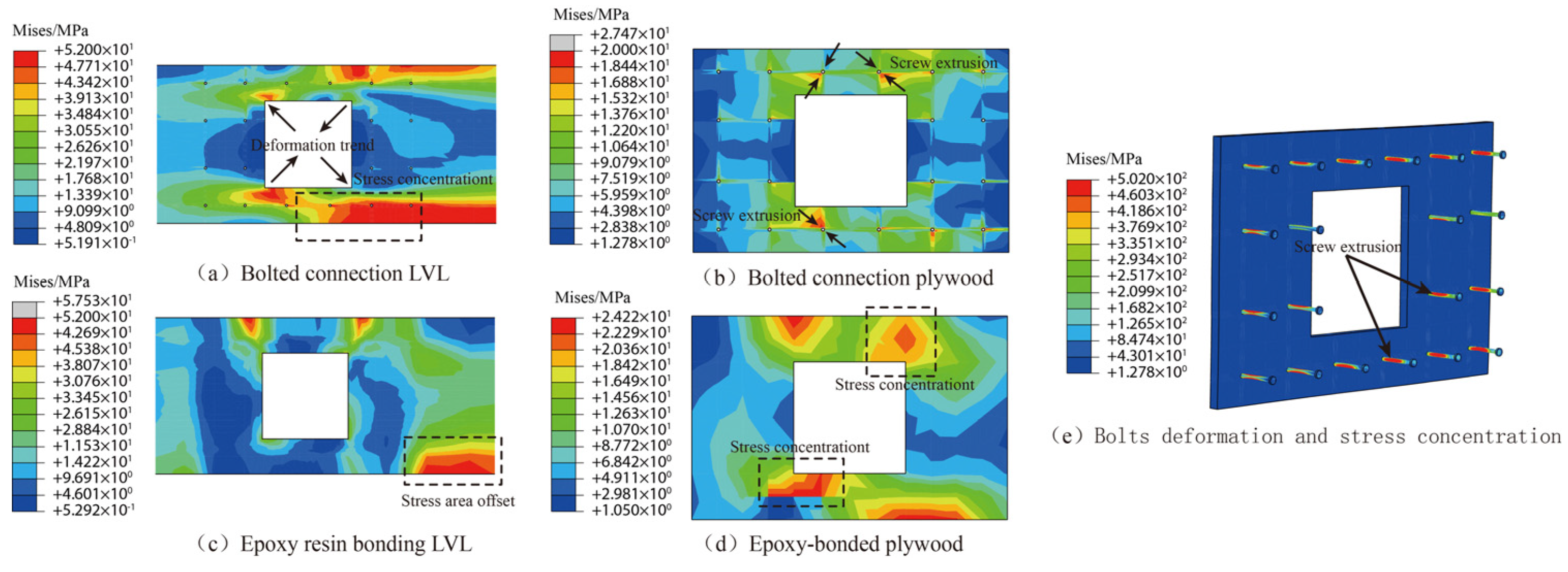
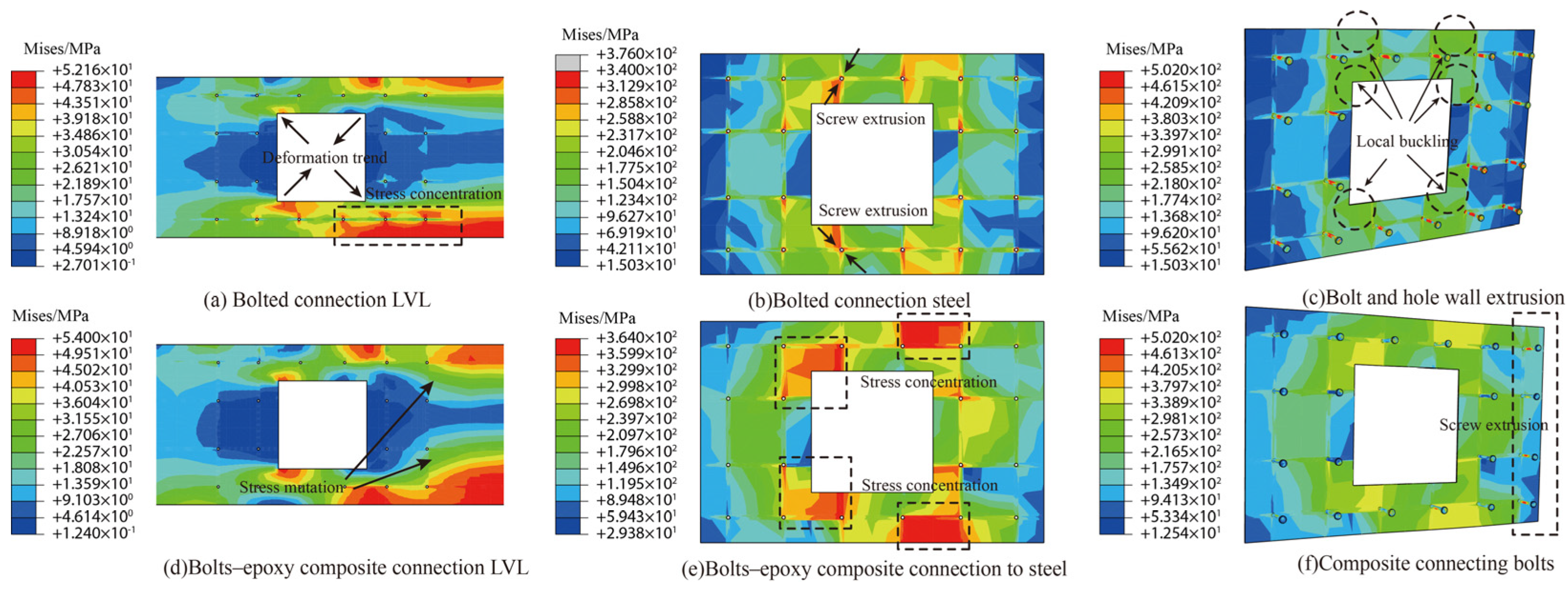
| E1/Mpa | E2/Mpa | E3/Mpa | G12/Mpa | G13/Mpa | G23/Mpa | V12 | V13 | V23 |
|---|---|---|---|---|---|---|---|---|
| 11,000 | 370 | 730 | 690 | 690 | 50 | 0.48 | 0.48 | 0.22 |
| Parallel Fiber Direction (MPa) | Vertical Fiber Direction (MPa) | Shear Modulus and Strength (MPa) | Fracture Energy (N/mm) | |||||||
|---|---|---|---|---|---|---|---|---|---|---|
| E1 | E2,3 | G12,13 | G23 | fv | GF,2 | GF,12 | ||||
| 13,200 | 30 | 42 | 400 | 2.02 | 12 | 660 | 50 | 4.6 | 0.7 | 1.2 |
| Es/Mpa | G1/Mpa | G2/Mpa | /Mpa | /Mpa | /Mpa |
| 1500 | 1500 | 1500 | |||
| GN/(J·mm−2) | GS/(J·mm−2) | GT/(J·mm−2) | 13.6 | 13.7 | 13.7 |
| 0.32 | 0.41 | 0.41 |
| NO | Ultimate Load Capacity/kN | Inaccuracies/% | Limit Displacement/mm | Inaccuracies/% | ||
|---|---|---|---|---|---|---|
| Test | FEA | Test | FEA | |||
| #1 | 44.58 | 45.52 | 2.1 | 35.47 | 36.14 | 1.9 |
| #2 | 40.66 | 41.88 | 3.0 | 35.98 | 36.84 | 2.4 |
| #3 | 87.35 | 90.23 | 3.3 | 37.94 | 39.08 | 3.0 |
| #4 | 87.08 | 88.47 | 1.6 | 38.50 | 39.04 | 1.4 |
| #5 | 182.90 | 179.61 | −1.8 | 38.08 | 37.20 | −2.3 |
| #6 | 136.65 | 137.61 | 0.7 | 27.84 | 28.15 | 1.1 |
| #7 | 66.69 | 65.16 | −2.3 | 18.52 | 18.24 | −1.5 |
| #8 | 67.33 | 70.09 | 4.1 | 17.91 | 18.50 | 3.3 |
| #9 | 224.64 | 233.40 | 3.9 | 25.24 | 26.30 | 4.2 |
| #10 | 76.75 | 80.13 | 4.4 | 13.56 | 14.31 | 5.5 |
| #11 | 81.54 | 82.03 | 0.6 | 11.26 | 11.45 | 1.7 |
| #12 | 34.36 | 35.94 | 4.6 | 10.29 | 10.72 | 4.2 |
| #13 | 35.54 | 36.46 | 2.6 | 13.51 | 13.78 | 2.0 |
| NO | Reinforcement Measures | Fa | Fai/Fa#8 | Fu | Fui/Fu#8 |
|---|---|---|---|---|---|
| #8 | / | 49.07 | 1.00 | 67.33 | 1.00 |
| B1 | Prestressing bolt | 50.49 | 1.03 | 86.31 | 1.28 |
| B2 | Fully threaded screw | 52.77 | 1.08 | 89.96 | 1.29 |
| B3 | Epoxy resin–plywood | 53.79 | 1.10 | 89.87 | 1.33 |
| B4 | Bolts–plywood | 52.58 | 1.07 | 98.97 | 1.47 |
| B5 | Bolts–CFTWS | 56.19 | 1.15 | 102.86 | 1.53 |
| B6 | Bolts–epoxy–CFTWS | 59.22 | 1.21 | 107.18 | 1.59 |
| NO | Reinforcement Method | Fu | Vu | VCLT | VLVL | Vplate | VCLT/VG | VLVL/VG | Vplate/VG |
|---|---|---|---|---|---|---|---|---|---|
| #8 | / | 67.33 | 29.46 | 8.25 | 21.21 | - | 0.28 | 0.72 | - |
| B1 | Prestressing bolt | 86.31 | 39.83 | 13.94 | 25.89 | - | 0.35 | 0.65 | - |
| B2 | Fully threaded screw | 89.96 | 41.84 | 15.60 | 26.24 | - | 0.37 | 0.63 | - |
| B3 | Epoxy resin–plywood | 89.87 | 42.51 | 10.78 | 18.58 | 13.15 | 0.25 | 0.44 | 0.31 |
| B4 | Bolts–plywood | 98.97 | 48.86 | 13.08 | 29.18 | 6.61 | 0.27 | 0.60 | 0.14 |
| B5 | Bolts–CFTWS | 102.86 | 49.91 | 6.99 | 15.47 | 27.45 | 0.14 | 0.31 | 0.55 |
| B6 | Bolts–epoxy–CFTWS | 107.18 | 52.22 | 4.26 | 8.14 | 39.83 | 0.08 | 0.16 | 0.76 |
Disclaimer/Publisher’s Note: The statements, opinions and data contained in all publications are solely those of the individual author(s) and contributor(s) and not of MDPI and/or the editor(s). MDPI and/or the editor(s) disclaim responsibility for any injury to people or property resulting from any ideas, methods, instructions or products referred to in the content. |
© 2024 by the authors. Licensee MDPI, Basel, Switzerland. This article is an open access article distributed under the terms and conditions of the Creative Commons Attribution (CC BY) license (https://creativecommons.org/licenses/by/4.0/).
Share and Cite
Wu, H.; Liao, W.; Yu, Y.; Dai, B.; Chen, Z.; Chai, H.; Lv, X. Study on Reinforcement Measures for Wood Composite Beams with Discontinuous Cross-Section in Web Opening. Forests 2024, 15, 1318. https://doi.org/10.3390/f15081318
Wu H, Liao W, Yu Y, Dai B, Chen Z, Chai H, Lv X. Study on Reinforcement Measures for Wood Composite Beams with Discontinuous Cross-Section in Web Opening. Forests. 2024; 15(8):1318. https://doi.org/10.3390/f15081318
Chicago/Turabian StyleWu, Haoxuan, Wenyuan Liao, Yue Yu, Bihui Dai, Zhiqiang Chen, Hangbin Chai, and Xinliang Lv. 2024. "Study on Reinforcement Measures for Wood Composite Beams with Discontinuous Cross-Section in Web Opening" Forests 15, no. 8: 1318. https://doi.org/10.3390/f15081318
APA StyleWu, H., Liao, W., Yu, Y., Dai, B., Chen, Z., Chai, H., & Lv, X. (2024). Study on Reinforcement Measures for Wood Composite Beams with Discontinuous Cross-Section in Web Opening. Forests, 15(8), 1318. https://doi.org/10.3390/f15081318






